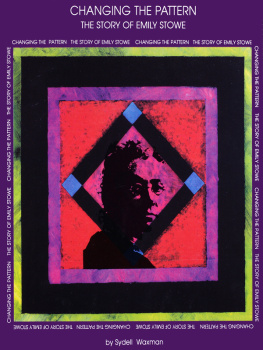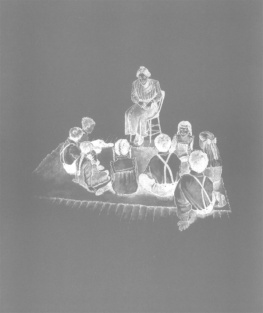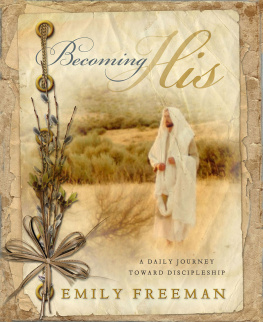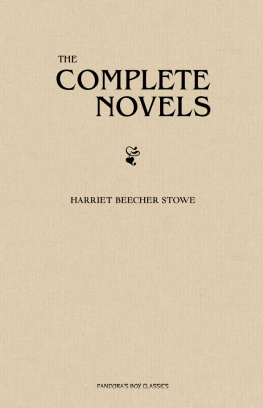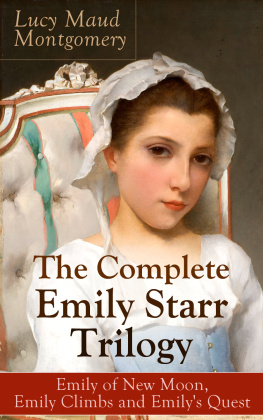
Changing the Pattern
The Story of Emily Stowe
by
Sydell Waxman
Text copyright 1996 Sydell Waxman
Illustrations copyright 1995 Linda Potts
All rights in this book are reserved. No part of this publication may be reproduced, stored in a retrieval system or transmitted, in any form or by any means, electronic, mechanical, photocopying or otherwise, without the prior written consent of the publisher.
Published by
Napoleon Publishing Toronto Ontario Canada
Napoleon Publishing gratefully acknowledges the support of the Canada Council toward its publishing program.
Cover design and book design by
Pamela Kinney
Printed in Canada
To my mother, Rose Zamikoff and all mothers, past and present S.W.
Canadian Cataloguing in Publication Data
Waxman, Sydell, date
Changing the pattern : the story of Emily Stowe
ISBN 0-929141-43-1 (bound). ISBN 0-929141-39-3 (pbk.)
1. Stowe, Emily Howard, 1831-1903 Juvenile literature. 2. Women physicians Canada Biography Juvenile literature. 3. Women Suffrage Canada History 19th century Juvenile literature. I. Potts, Linda, date . II. Title.
R464.S76W38 1995 j610.92 C95-931598-5
Changing the Pattern
The Story of Emily Stowe
by Sydell Waxman

Illustrations by Linda Potts

Napoleon Publishing
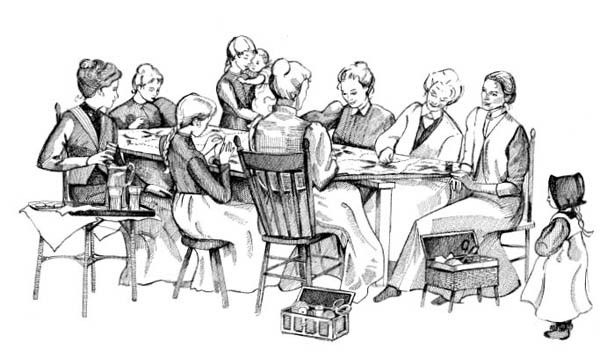
Contents
The Same Pattern

When Emily Howard Jennings was born in 1831, girls lives followed a set pattern. Some girls secretly dreamed of becoming doctors or lawyers. Others just wished for a good education. Their dreams remained empty wishes, unlikely to come true. In the Victorian age, every girls future was limited to housework and child care.
Quilt-making gave women the rare opportunity to make choices. They picked from a rainbow of colours and threads, creating their own unique patterns.
Emily struggled to make womens lives more like quilting, something they themselves designed and directed.
Despite extreme opposition, Emily Stowe became the first woman school principal and the first woman to practise medicine in Canada. As a leader, a speaker and a fighter for womens rights, she gradually changed laws and attitudes.
How did she do it?
QUILT-MAKING
Quilt-making was womens work. Women gathered together at quilting bees to share stories and sewing decisions. They worked together on one large quilt or on a sampler quilt which was arranged in block form, piece by piece.
A New Dream
Little Emily often dreamed about becoming a doctor. She watched as her mother Hannah and other Quaker women prepared medicine for their families. When she was old enough, she applied to the Toronto School of Medicine.

Emilys application shocked the University Senate. All doctors at that time were men. Since a woman had never applied for medical courses, the Senate didnt know what to do. Her papers were sent to John McCaul, President of the University of Toronto. McCaul was annoyed with Emily, but agreed to discuss her application.
As Emily guided her horse and carriage to the front of the huge university building, her heart kept pace with the heavy clopping of her horses hooves. Could the men on the Senate do something that had never been done before? Would they accept a woman into the university?
In his office, McCaul spoke sternly. Her case, he said, had been debated for a long time. The Senate had reached a decision. Women were not allowed.
Emily breathed quickly. This was unfair. Why? she asked. McCaul answered that boys were used to studying with other boys. Girls belonged at home.
THE VICTORIAN AGE
Victoria was Queen of Britain from 18371901. During this period, called the Victorian age, there were strict rules about what a woman could and could not do. Most girls didnt even go to school. If her parents were rich, she went to a private school where she learned things like painting, piano playing and needlepoint.
The Promise
Emily was a short woman, but she jolted upright and stood stiffly before this powerful man. Your Senate may refuse to admit women now, but the day will come when these doors will swing wide open to every female who chooses to apply.
McCaul was not impressed with Emilys boldness. Never in my day, Madam. The doors of the University are not open to women and I trust they never will be.
Emily vowed, Then I will make it the business of my life to see that they will be opened, that women may have the same opportunities as men.
Emily never forgot this promise. But before she could change the lives of all Canadian girls, she had to struggle to change her own future, by adding pattern pieces to her own life.
Where did she get the courage?

DR. JAMES MIRANDA STUART BARRY
There was one female doctor in Canada before Emily. For 46 years, Miranda Barry dressed as a man and called herself James Barry. When she was Inspector-General of Military Hospitals in Canada from 1857-1861 no one guessed she was a woman. Her secret was discovered after she died and her body was being prepared for burial. Many people told Emily to copy Miranda, but Emily wanted women to be accepted as themselves.
Society Of Friends
When Emily was born in 1831, her parents, Hannah and Solomon Jennings, were just as happy to have a girl baby as a boy. Like all Quakers, they believed that every persons soul contained the seed of God. The Quakers were the first religious group to accept women as equals.
In her town, called Norwich, a Quaker farming community west of Toronto, Emily saw Quaker women become ministers. She watched as women stood and spoke freely at Quaker meetings.
Emily didnt know that the rest of Canada had rigid ideas about girls education and work. At home, on the farm, everyone shared the never-ending chores.

QUAKERS
The Quakers are a religious group founded over 300 years ago in England by George Fox. They called themselves The Society of Friends, but other people called them Quakers because they shook with emotion at their meetings. Like all Quakers, Emilys family called each other friend or brother and used the words thee and thou.
SILENT MEETINGS
At the Quakers meeting house, the elders sat on a raised platform. There was no leader, so the Quakers prayed in silence. If someone felt the need to express an idea, he or she just spoke out. The meeting was over when no one had any more comments.
Work Thats Never Done

Next page
